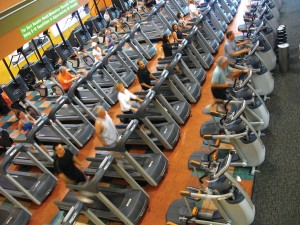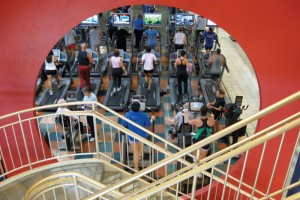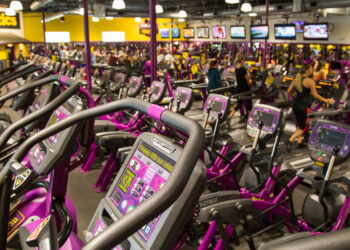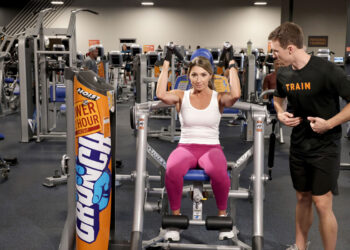 How would you feel if someone walked into your home and there was the lingering smell of sweat, trash scattered throughout rooms and the bathroom had an odor that was indescribable? The situation would be pretty embarrassing and the person probably wouldn’t return to your home. This is the same situation when members and prospects come into a dirty club for the first time; and, in the fitness industry, being clean can easily determine a club’s success or failure.
How would you feel if someone walked into your home and there was the lingering smell of sweat, trash scattered throughout rooms and the bathroom had an odor that was indescribable? The situation would be pretty embarrassing and the person probably wouldn’t return to your home. This is the same situation when members and prospects come into a dirty club for the first time; and, in the fitness industry, being clean can easily determine a club’s success or failure.
Keep It Clean
Keeping the club clean is number one or two on the list of importance. If the club isn’t clean, members won’t want to return to the club and the club won’t make money.
Erica Smith, the facilities manager for Gainesville Health and Fitness Clubs (GHFC), said that clubs needed to focus on locker rooms first and foremost. “A much higher amount of time needs to be devoted to keeping this area clean,” she said. “Aside from getting the highest percentage of traffic, it is the most multifunctional space in the facility. Because of the higher rate of traffic and the variety of activities in the area, it becomes a complicated area to keep clean. Each center should establish their cleaning routines and expectations based on the traffic and usage of each area.”
GHFC’s members are very active in aquatic classes in the early afternoon. “Therefore, we need to establish a stronger and more frequented cleaning routine during that time frame,” Smith explained. “We clean the locker room and showers a minimum of four times a day.”
Cleaning the locker rooms multiple times a day is a great way to ensure that they remain clean. However, without structure, the rooms are just being wiped down and not disinfected. “An extensive checklist system with supervisors inspecting with the staff is how we make sure our clubs are clean,” Smith said. “We have an entire department devoted to keeping the clubs clean. This includes a department head, two supervisors, a shadow team and a staff of over 40 housekeepers. Our housekeepers do a great job of holding themselves accountable as well, but the supervision of the department is how we keep things running smoothly and grow into an integral part of club operations.”
Tag Entwisle, the regional president of Minnesota for Titan Fitness, Gold’s Gym Minnesota, said that making clean schedules could be one of the most important aspects of the cleaning process. Not only does the club need to stay clean, but also the cleaning crew doesn’t need to be noticed significantly by the members. “We also conduct an hourly walk-through with a detailed check list for the entire staff to follow and participate,” Entwisle said. “These check lists are audited and looked at everyday. Our management staff also has a specific walk-through and spot-check for cleanliness on their daily task list.”
The Clean Challenge
In high-volume clubs, the equipment struggles to stay clean with constant usage. “One area that is hard to keep up with is when people leave gum or trash in the drink holders,” Entwisle explained. “Here in Minnesota, there is a lot of snow and salt that is dragged into the clubs on people’s shoes. This makes it even tougher in the wintertime for us to keep the clubs clean. The solution to this is just making it a priority every hour, day and week.”
Entwisle’s team puts up constant reminders to staff and members to wipe off the cardio machines in order to ensure the equipment stays clean for each individual member. “We have consistently busy floors of cardio equipment and the housekeepers have to take the opportunity when the machines are open,” Smith said. “There are times during any given day that there are members using every piece of cardio equipment on the floor. We can get a lot of the cleaning done at night, however you lose a lot of the accountability for the results.”
The biggest problem with cardio equipment is all the moisture that gets onto the machines. Members are going to sweat and breathing hard may get saliva onto the monitors. “Much of the germ transfer to members happens from hands to face, eyes to mouth,” explained Michael Hanes, the market development director for GOJO Industries. “Alcohol-based instant hand sanitizers can be an effective way of combating this danger.”
Hanes said the biggest challenge clubs may face has to do with communicating and educating members on the club’s commitment to cleanliness within its facility. “Often clubs gloss over their cleaning protocols and overall commitment to a clean facility when discussing the club’s offering with prospective members,” Hanes said. “Recent research has shown that cleanliness is the factor that has the greatest influence on a member’s long-term commitment to a club.”

Smith explained that one of the hardest aspects of cleaning a club is the member’s expectation. “This is always a challenge, but in a good way,” Smith said. “Some members take more time and accommodation, some do not want staff to clean around them and others want to see the housekeepers taking care of their area. We listen to our members by doing focus lunches, having suggestion boxes around the club and on our Web site.”
“We have high expectations which we feel falls in line with our member expectations as well,” Entwisle said. “We like to talk to members openly about ‘what’ and ‘how’ they feel we can make the club better. Also, we like the management staff to be very visible just in case a member has a concern or an idea that can make us a better club or corporation.”
Members don’t expect to get sick after attending their club. The fitness club is supposed to be a place of good health, but with so many people coming in and out staying clean can be difficult. “No matter how well the staff cleans a machine, it will still be dirty when the next member uses it,” Smith said. “Members have to take ownership of their club and use the available resources to protect themselves. There are many products available to get members involved in the upkeep of a facility, but it is up to the staff to educate the members on how and why they should do it. We provide wipes for members to clean the machines after each use. Because of this, there is an added comfort in knowing that the machines are as sanitary and clean as possible.”
“Equipment cleaning solutions in the club setting need to have some level of chemicals as the active germicidal ingredient to be effective,” said Dr. Bruce Sherman, the president of GymValet. “One of the most effective and universally used hard surface sanitizing agents is ‘quaternary ammonium.’ Quats., when used properly, are ‘human-contact safe’ – a very important factor as exercisers touch equipment after sanitizing. Cleaning solutions with the most ‘mild’ human-contact warnings on their Material Safety Data Sheets (MSDS) are your best bets for equipment surface sanitizing.”
Most clubs don’t let one area go, while the others are targeted heavily. In a club, it’s important to focus on the whole to make sure germs don’t infect members. “It’s not that areas of clubs are overlooked,” said Cheri Heberling, the owner of Super Body Care. “It’s the hygiene of the customers that is overlooked. Just because most customers are adults, it doesn’t mean they have the best hygiene practices.”
Heberling suggests keeping members aware of their hygiene through signage and other types of clean notifications. “Your club stays clean if your members stay clean,” she said. “Frequently remind people to wash their hands before working out or using equipment. Hands make the best vehicles to transfer pathogenic bacteria, fungi and viruses.”
Green Cleaning
Many clubs believe that by “going green” they need to focus on the toxins that are in the cleaning supplies. However, many times owners and general managers don’t have backgrounds in chemistry, which prevents them from understanding “green” chemicals. Regardless, this lack of knowledge doesn’t prevent clubs from making green efforts.
“Our commitment to green revolves around eliminating the use of expensive disposable paper towels and synthetic pre-moistened wipes from the equipment cleaning process,” Dr. Sherman said. “Disposables unnecessarily contribute to the landfill. Synthetic wipes have been likened to disposable diapers regarding the time it will take to bio-degrade – about 500 years.”
“Purchasing bulk-gallon-size liquid personal care products and placing them in beautiful-refillable dispensers in showers and on vanities is not only a great way to reduce cost, but also it’s a ‘green’ alternative to using throw-away bottles,” said Laurie Schmidt, the president and owner of Sports Solutions Inc.
There are many ways to make sure your club stays clean, and many ways to go “green.” Clubs can have intense cleaning crews that scour the club every second of the day and clean up after members, or they can let the club go throughout the day and perform a massive overhaul at night. However, the emerging trend seems to be a little of both worlds with a little help from the members.
Clubs need to provide members with simple tools and encourage employees to instruct members on proper ways of cleaning the equipment. If members complain about employees instructing too much, start using more signage. If members do their small part to help keep the club clean, that will take the pressure off the club, the cleaning crew and everyone that enters the club. -CS









This is a huge issue at our club, yet I see some of this going overboard: immediately after H1N1 became a concern you could tell who the obsessive-compulsive, germophobes were – they were not only wiping down machines (which is good); they were using nearly an entire spray bottle on every machine, all the time, to the point where half the bottle was being used by one person. This is inappropriate. It is a waste of cleaning product, it is a waste of paper towels, and it’s counterproductive. I think there has to be a better way to sanitize equipment without needing towels, or a way of providing sanatizing product that isn’t misused and wasted. I don’t know (in dollars) what this is costing us, but we are always refilling our spray bottles from members (who practically hose down the machines for them to use, yet they never wipe those same machines after they complete their routine). Again, this is something I did not see a year ago (to this extent) so I am hoping that there are new ways of developing sanitizer that isn’t wasted or misused. As well, it has become clear to me that about 80% of the population has no idea how virus is spread. I know that those who need to be educated about these issues rarely listen, but again, there needs to be a clear discussion to lessen the paranoia of ‘catching something from the machines’.